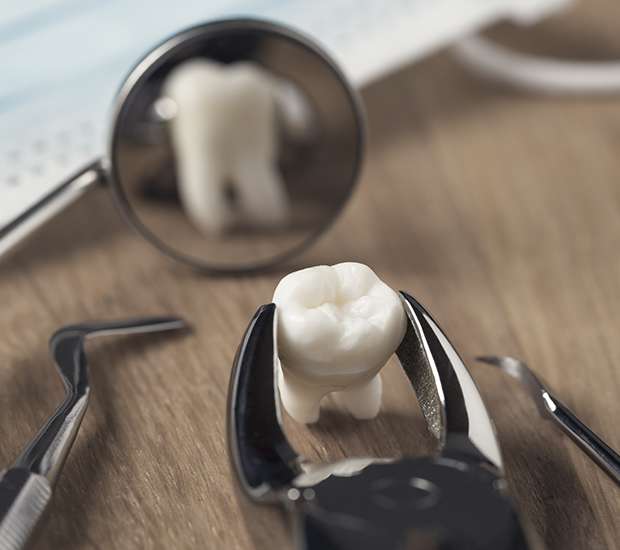When Is a Tooth Extraction Necessary Miami, FL
As a family dentist in Miami, FL, we are regularly asked, "When is a tooth extraction necessary?" This is an understandable question because no one wants to have a tooth pulled unless it is absolutely beneficial. We are not interested in extracting teeth unless absolutely necessary. In fact, if you damage a tooth, our preferred method of treatment is to restore it using dental veneers or dental crowns. There are times, however, where we do recommend visiting our dental office located at 2685 Bird Ave Suite A Miami, FL 33133 for an extraction.
You were in an accident.
We can treat patients who have gotten into an accident and need to have immediate dental work completed. In some cases, dental damage is only part of the problem and immediate solutions are necessary. If possible, we will restore the tooth using dental bonding, dental veneers, or dental crowns. However, if the problem is urgent, a tooth extraction may be necessary. If you do need an emergency dentist, call (305) 858-0505 to schedule an appointment.
An infection has spread.
If you have a bad dental infection, visit a dental office as soon as possible. It will be obvious if the infection has spread since you will experience intense discomfort that will make it difficult to bite down, chew, or even carry on with daily activities. We recommend coming in at the first sign of a toothache so we can treat the infection before it reaches the point of being severe. However, if you have delayed an appointment and are now in intense pain, you may need a tooth extraction just to get rid of the infection quickly. While not ideal, we can eliminate the source of the problem, prescribe you antibiotics, and then replace the tooth or teeth in the future with dental crowns and bridges or dental implants.
Check out what others are saying about our tooth extraction support services on Yelp: When Is a Tooth Extraction Necessary Miami
The cost to restore the tooth is too great.
We accept most insurance plans and can also discuss various payment options with you. However, we also realize that sometimes restorative dental work can be cost prohibitive. This is not an inexpensive teeth whitening procedure. Instead, removing an infection can require a full root canal and restoration afterward. If you are in a situation where you cannot afford a root canal, you may want to consider a tooth extraction and then replace the tooth later on when you have the funds to do so. This will address the immediate problem, which is to remove the infection.
Your wisdom teeth are impacted.
One of the most common reasons parents ask, "When is a tooth extraction necessary?" is because their child is developing wisdom teeth. At Dr. Rita The Smile Designer, we do not always extract wisdom teeth. If there is enough room in the mouth for this third set of molars and they are growing in straight, they may be able to remain in the mouth. However, it does not work this way for most people. In fact, it is more common for our patients to visit our dental practice complaining that their wisdom teeth hurt. This can happen when they grow in impacted. The actual growth of them can cause discomfort and push other teeth forward (inconvenient if you or your child has had braces). As they grow in impacted or sideways, space will be created for food to become trapped, and this area often becomes infected. In this way, wisdom teeth can pose a health risk. As a cosmetic dentistry office, we can remove them.
The Extraction Process
While the first question we hear is, "When is a tooth extraction necessary?", the second is always about the process. We understand that our patients are often intimidated by the prospect of needing to have a tooth extracted. This is a process that most people grow up fearing, in part because of popular movies and television conveying an extraction as something truly horrible. The good news is that we can complete the extraction gently, quickly, and while keeping you comfortable. When looking for a "dentist near me" to complete an extraction, be sure to visit one who offers sedation. We do and we will use it to help you relax. Before we get started, you will be sedated and you will receive medication to numb the area.
If your tooth has grown in straight…
We can typically grasp the tooth, wiggle it, and gently but quickly pull it out. This process happens quickly, and afterward, we will clean the area and place gauze there to stop the bleeding.
If your tooth is impacted…
As a cosmetic dentist, we remove impacted teeth as a matter of course. This process, however, is far more complicated because an impacted tooth cannot be pulled. Instead, we have to cut open the gum tissue that surrounds the tooth so we can fully access it. In some cases, other bone or tissue has to be cut away so we have full access to the tooth and can pull it out. If necessary, we may need to pull it out one piece at a time. Afterward, we will clean the area, replace the gum flap, place sutures if necessary, and treat it with gauze.
The Recovery Process After a Tooth Extraction
At Dr. Rita The Smile Designer, we warn patients that they will be sore for several days and that they will experience some swelling. This is perfectly natural and can be controlled by taking ibuprofen and placing a cold compress or icepack on your face in the area where the tooth was extracted. We encourage our patients to do so for 15 minutes at a time. In preparation for your tooth extraction, you should buy plenty of JELL-O, yogurt, applesauce, and anything else you can eat without actually needing to chew. Within a couple of days, you should be able to add solids back into your diet but will need to be cautious until the area has healed completely.
Schedule an Appointment
To find out if you need a tooth extraction, call 3058580505 and schedule an appointment with Dr. Rita The Smile Designer. We will be happy to answer any questions you have, schedule your procedure, and replace your teeth with dental implants or dental crowns and bridges once the extraction has been completed.
Questions Answered on This Page
Q. When is a tooth extraction necessary?
Q. What happens during the extraction process?
Q. What is the recovery process after an extraction?
People Also Ask
Q. Which tooth replacement is right for me?
Q. Can dental bridges replace my missing teeth and restore my smile?
Q. Are dental implants better than dentures or dental bridges?
Definition of Dental Terminology
- Cosmetic Dentistry
- Cosmetic dentistry combines comprehensive dental principles with artistic sensibility to design and create optimally healthy and beautiful restorations intended to enhance the appearance of one’s smile while preserving ideal function and form.
- Decay
- Tooth decay is when the enamel of the tooth begins to breakdown as a result of bacterial invasion, causing an acidic induced erosion of healthy tooth structure.
- Dental Caries
- Dental caries are also known as cavities and can result from a lack of proper oral hygiene. A synonym of “decay”, and also called “cavities”, caries is a breakdown of teeth due to acids made by bacteria. The cavities may be a number of different colors from yellow to black.
- Dental Checkup
- A comprehensive oral examination that focuses on the evaluation of hard and soft oral structures including, but not limited to, the teeth, gums, jaw bone, jaw joint, bite, and cosmetic aspects of the smile. Both clinical and radiographic information is used to assess the status of the oral health while detecting any form of pathology that may affect the health of the oral cavity and its associated structures.
- Dental Filling
- A dental filling involves restoring the damaged structure of a tooth by using tooth colored resins or porcelain materials to restore natural form, function, and estethetics to the dentition.
- Dental Prophylaxis
- A dental prophylaxis is a professional and detailed cleaning that involves the removal of plaque, calculus and stains from the teeth,thereby reducing the risks of inflammation and breakdown of the dentition’s supporting structures.
- Dental Sealants
- Dental sealants are preventative restorations that contain a resinous material that is applied to the deep pits and fissures detected on the chewing surfaces of newly erupted teeth. These are used to help prevent dental caries from developing in children’s permanent molars and premolars.
- Dentist
- A dentist, also known as a dental surgeon, is a doctor who specializes in the diagnosis, prevention, and treatment of diseases and conditions of the oral cavity.
- Gingivitis
- Gingivitis is the inflammation of gum tissue that results from plaque, other infections in the mouth, and poor oral hygiene. Gingivitis can be a precursor to more advanced forms of periodontal disease if it is not controlled and reversed. Signs of gingivitis include soft tissue redness,inflammation, and bleeding. Proper brushing, flossing, and prevention helps to prevent and reverse signs of early gum disease.
- Preventive Dentistry
- Preventive dentistry focuses on education, modalities, and treatment designed to achieve and maintain optimal oral health, described as one free of structural, bacterial, and restorative breakdown.
- Tartar
- Tartar forms when plaque builds up on the surface of the teeth and calcifies into a hard surface that is much more difficult to remove. Its presence will require professional dental debridement and education on its prevention. Daily removal of plaque by proper brushing and flossing habits will reduce the incidence of tartar and the pathology associated with its presence.
- Tooth Enamel
- Tooth enamel is the outermost protective layer of the tooth. Enamel is white and visible. Its hard composition protects the underlying layers, dentin and pulp, respectively.
Back to top of When Is a Tooth Extraction Necessary




